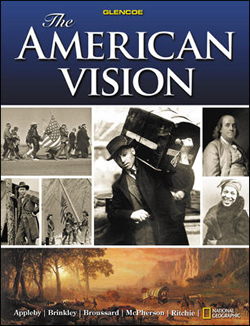The American Vision © 2008Chapter 1:
Colonizing AmericaWeb Lesson PlansIntroduction
Students have read about the ancient culture of the moundbuilders of the Mississippi and Ohio Rivers. In this activity they will explore remnants of ancient mounds and discover what archaeologists have determined about the Mississippian culture. Lesson Description
Students will use information from the Ancient Architects of the Mississippi Web site to learn about archaeological studies of the Mississippian mounds. They will read about archaeological discoveries and what the finds suggest about the moundbuilders' lives. By linking to national and state park Web pages, students will also view pictures of mounds and mound artifacts. Students will then answer four questions and apply this information by preparing a brief oral presentation that introduces one of the park sites and provides background information on the Mississippian culture. Instructional Objectives- Students will identify the ancient Mississippians and explain characteristics
of their communities that define their culture.
- Students will be able to use this knowledge to prepare a brief oral presentation
that introduces a mound ruin and provides a summary of the ancient Mississippians.
Student Web Activity Answers- At several of the ancient sites, smaller mounds encircle a larger mound. The earth is built up in the form of mounds and then leveled at the top. In ancient times Mississippians built houses of thatch and mud plaster in the fields surrounding the mounds. Communities usually had from one to twenty mounds, upon which temples or other important structures were built. Mounds were sometimes arranged around a rectangular plaza, surrounded by the village. Burial mounds were rounded or conical, whereas temples or houses of the elite were built on four-sided flat-topped mounds. Evidence left within the mounds suggests that the Mississippians had vast trade networks and that they were skilled craftspeople.
- Copper, which was made into bracelets, rings, and other jewelry; shells, which were made into necklaces and decorated disks; tools and utensils.
- Some believe that the Mississippians fell victim to their own success, and their cities suffered the same problems as other thriving cities: overpopulation, inadequate sanitation, and overstressed natural resources. Epidemics and mass migrations may also have forced inhabitants to abandon the cities. In addition, archaeologists have found evidence of war, indicating sociopolitical problems.
- Most mounds, located along remote fields and waterways, have weathered into unassuming shapes. Looting, farming, and development have caused further damage.
- Students' oral presentations will vary.
 | 




